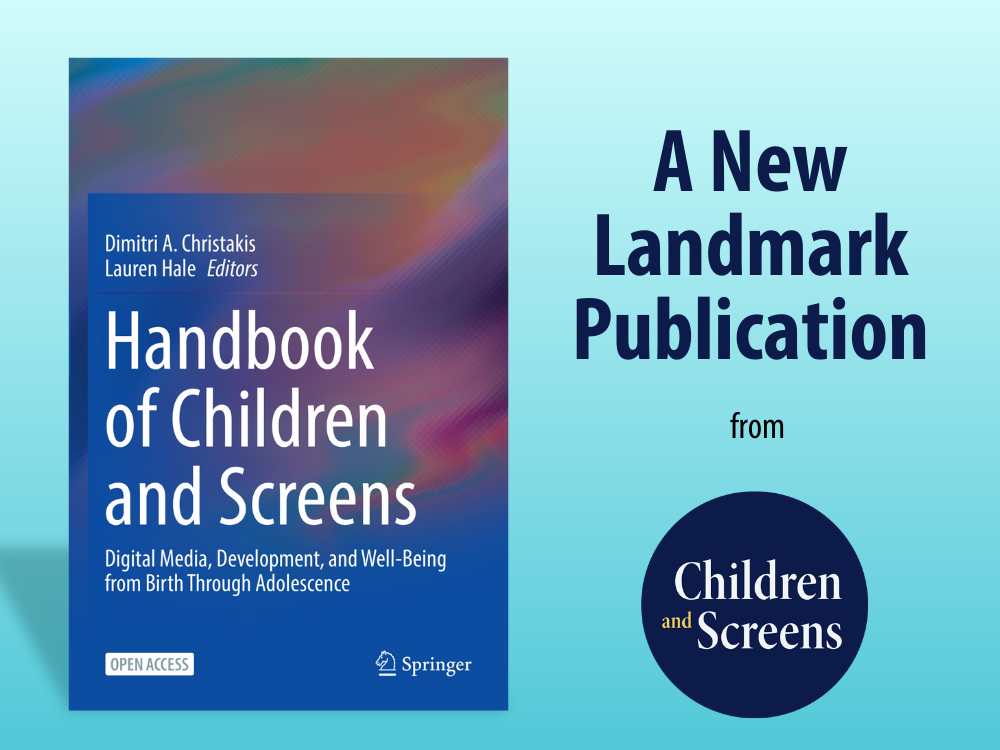
 Children and Screens: Institute of Digital Media and Child Development is pleased to announce the release of its highly anticipated publication, Handbook of Children and Screens: Digital Media, Development, and Well-Being from Birth Through Adolescence. This comprehensive volume offers the latest research, expert insights, and actionable recommendations in the field of digital media’s effects on children, adolescents, and their families. By distilling the most critical new findings, the handbook provides an up-to-date resource for policymakers, educators, healthcare professionals, and parents navigating today’s rapidly evolving digital landscape.
Children and Screens: Institute of Digital Media and Child Development is pleased to announce the release of its highly anticipated publication, Handbook of Children and Screens: Digital Media, Development, and Well-Being from Birth Through Adolescence. This comprehensive volume offers the latest research, expert insights, and actionable recommendations in the field of digital media’s effects on children, adolescents, and their families. By distilling the most critical new findings, the handbook provides an up-to-date resource for policymakers, educators, healthcare professionals, and parents navigating today’s rapidly evolving digital landscape.
Featuring contributions from nearly 400 respected experts in child development, psychology, health, digital media research, and more, this handbook provides a deep dive into how screens impact the physical, mental, and social well-being of children and adolescents.
Kris Perry, Executive Director of Children and Screens, introduces this initiative by emphasizing the depth and breadth of interdisciplinary evidence and the pressing need for informed action on children’s media use. “This handbook represents the expertise of the nation’s leading scholars and practitioners, providing a unique synthesis of the intricate interplay between screen use and the health, development, and well-being of children and adolescents,” said Perry.
This handbook represents the expertise of the nation’s leading scholars and practitioners, providing a unique synthesis of the intricate interplay between screen use and the health, development, and well-being of children and adolescents.

“Since 2017, the domain of children and media has transformed dramatically—platforms like TikTok, virtual reality, and generative artificial intelligence are now at the forefront. Each day, new reports highlight the potential risks posed by these platforms, fueling global conversations about the urgent need to ensure digital landscapes are designed with children’s basic rights and needs in mind.”
She added, “We must remain steadfast in our commitment to foster a balanced approach to digital media that maximizes the benefits and mitigates the risks for children. This comprehensive, open-access handbook will serve as an invaluable resource for researchers, practitioners, policymakers, educators, and caregivers alike, empowering us all to promote the optimal well-being of our children in the digital age.”
The handbook explores several critical topics, including youth mental health and social media, addressing how social media platforms may contribute to anxiety, depression, and body image concerns among adolescents. It provides strategies for mitigating these effects and promoting digital well-being among youth, as well as insights into regulatory approaches. It also dives into problematic internet use and addictions, offering practical strategies for parents and educators to address gaming disorders and excessive screen time, while advocating for further research into digital addiction.
Looking toward the future, the handbook examines how emerging technologies like AI, virtual reality, and social robots influence cognitive and social growth in children, while raising ethical questions about their use. It also covers evidence-based guidelines on screen time, outlining physical consequences like eye strain and sleep disruption, and advises parents on setting healthy boundaries. Finally, it presents policy recommendations, including insights from the Institute’s recent report on the UK’s Age Appropriate Design Code, advocating for similar legislative action in the U.S.
The full list of sections includes:
- Cognitive Effects, Brain Development, and Digital Media
- Digital Media and Physical Health
- Digital Media and Mental Health
- Problematic Use of the Internet in Children and Adolescents
- Youth Digital Well-Being
- Race, Racism and Digital Media
- Gender, Sexuality and Digital Media
- Parenting in the Digital Age
- Cyberbullying and Digital Cruelty
- Media Policy
- Education Technology
- Video Gaming, Violent Video Games and Gambling
- Emerging Technologies
Each section features individual chapters from today’s leading researchers.
The handbook will serve as a critical resource in shaping future policies and educational strategies. With growing public concern about the mental and emotional toll of digital media on young people and recent policy changes from platforms like Instagram, the handbook not only provides a comprehensive overview of digital media’s effects on kids but also offers actionable insights for improving their well-being. Drawing on the latest research, Children and Screens supports evidence-based regulations for social media platforms, clearer screen time guidelines, and continued expansion of research to help children lead healthy lives in a digital world.
Children and Screens: A Handbook on Digital Media and the Development, Health, and Well-being of Children and Adolescents is available for direct download [PDF].
About Children and Screens:
Children and Screens: Institute of Digital Media and Child Development is at the forefront of research on how digital media affects children’s development. The Institute advocates for sound public policy, educates the public on the impacts of screen use, and supports interdisciplinary research.
About the Editors:
Dimitri Christakis, MD MPH is the George Adkins Professor of Pediatrics at the University of Washington, the Chief Health Officer at Special Olympics International, Editor in Chief of JAMA Pediatrics, and Chief Science Officer at Children and Screens: Institute of Digital Media and Child Development. He has devoted his career to investigating how early experiences impact children and to helping parents improve their children’s early learning environments. He and his colleagues in the Christakis Lab have made a number of landmark findings, including discovering that young children who watch TV are more likely to develop attention problems and other health and behavioral issues. He is the author of more than 250 original research articles, a textbook on pediatrics, and co-author of the book, The Elephant in the Living Room: Make Television Work for Your Kids. He has appeared on CNN, NPR, Today, CBS News, ABC News, and NBC News and was recently featured as a TEDx speaker.
Lauren Hale, PhD is a Professor of Family, Population, and Preventive Medicine, Program in Public Health, at Stony Brook University’s Renaissance School of Medicine. She studies the social patterning of sleep health and how it contributes to inequalities in health and well-being with current or previous funding from NICHD, NIDDK, NHLBI, NIA, and the Della Pietra Family Foundation. Dr. Hale is interested in sleep health equity, policies related to sleep health (i.e. high school start time, daylight saving time), and behavioral modifications (i.e. reducing evening screen use, increasing physical activity) for improving sleep health at the individual and population level. Dr. Hale has over 175 peer-reviewed journal articles. Dr. Hale recently served on the National Sleep Foundation’s Board of Directors (including as Chair and Vice Chair) and is the founding Editor-in-Chief of the journal Sleep Health. She also serves on the Scientific Advisory Panel of the Pajama Program and Children and Screens.
For more information on Children and Screens, please contact Jon Bleicher at Prospect PR [jon@prospectpr.com, 973.330.1711]

